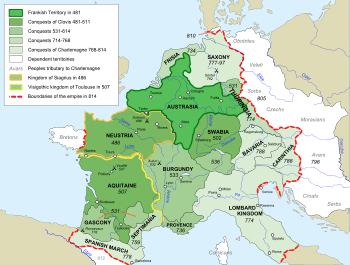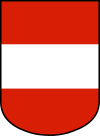Carantania
Carantania, also known as Carentania (Slovene: Karantanija, German: Karantanien, in Old Slavic *Korǫtanъ), was a Slavic principality that emerged in the second half of the 7th century, in the territory of present-day southern Austria and north-eastern Slovenia. It was the predecessor of the March of Carinthia, created within the Carolingian Empire in 889.
Origin of the name
The name Carantania is of pre-Slavic origin. Paul the Deacon mentions Slavs in Carnuntum, which is erroneously called Carantanum (Carnuntum, quod corrupte vocitant Carantanum).[1]
Another possible etymology is that it may have been formed from a toponymic base carant- which ultimately derives from pre-Indo-European root *karra meaning 'rock', or that it is of Celtic origin and derived from *karantos meaning 'friend, ally'. Its Slovene name *korǫtanъ was adopted from the Latin *carantanum. The toponym Carinthia (Slovene: Koroška < Proto-Slavic
- korǫt’ьsko) is also claimed to be etymologically related, deriving from pre-Slavic *carantia.[2]
Territory
Carantania's capital was most likely Karnburg (Slovene: Krnski grad) in the Zollfeld Field (Gosposvetsko polje), north of modern-day town of Klagenfurt (Celovec). The principality was centered in the area of modern Carinthia, and included territories of modern Styria, most of today's East Tyrol and of the Puster Valley, the Lungau and Ennspongau regions of Salzburg, and parts of southern Upper Austria and Lower Austria. It most probably also included the territory of the modern Slovenian province of Carinthia. The few existing historical sources distinguish between two separate Slavic principalities in the Eastern Alpine area: Carantania and Carniola. The latter, which appears in historical records dating from the late 8th century, was situated in the central part of modern Slovenia. It was (at least by name) the predecessor of the later Duchy of Carniola.
The borders of the later Carantania state, which was under the feudal overlordship of the Carolingians, and its successor (the March of Carinthia, 826-976), as well as of the later Duchy of Carinthia (from 976), extended beyond historical Carantania.
History

In the 4th century Chur became the seat of the first Christian bishopric north to the Alps. Despite a legend assigning its foundation to an alleged Briton king, St. Lucius, the first known bishop is one Asinio[3] in 451 AD.
In the 6th century, the Alpine Slavs, who are reckoned to be ancestors of present-day Slovenes, settled the eastern areas of the Friulia region. They settled in the easternmost mountainous areas of Friuli, known as the Friulian Slavia, as well as the Karst Plateau and the area north and south from Gorizia.
After the fall of the Ostrogothic Kingdom in 553, the Germanic tribe of the Lombards invaded Italy via Friuli and founded the Lombard Kingdom of Italy, which no longer included all of Tyrol, only its southern part. The northern part of Tyrol came under the influence of the Bavarii, while the west probably was part of Alamannia.
In 568, the Langobards receded into Northern Italy. Subsequently, in the last decades of the 6th century, Slavs settled in the depopulated territory with the help of their Avar overlords. In 588 they reached the area of the Upper Sava River and in 591 they arrived in the Upper Drava region, where they soon fought with the Bavarians under Duke Tassilo I. In 592 the Bavarians won, but three years later, in 595 the Slavic-Avar army gained victory and thus consolidated the boundary between the Frankish and the Avar territories.[4] By that time, today's East Tyrol and Carinthia came to be referred to in historical sources as Provincia Sclaborum (the Country of Slavs).[5][6]
In the 6th century, the Alpine Slavs, who are reckoned to be ancestors of present-day Slovenes, settled the eastern areas of the Friuli region. They settled in the easternmost mountainous areas of Friuli, known as the Friulian Slavia, as well as the Kras Plateau and the area north and south from Gorizia. In the 6th century Chur was also conquered by the Franks.[7]
Slavic settlement in the Eastern Alps region is proven by the collapse of local dioceses in the late 6th century, a change in population and material culture, and most importantly, in the establishment of a Slavic language group in the area. The territory settled by Slavs, however, was also inhabited by the remains of the indigenous Romanized population, which preserved Christianity.
Slavs in both the Eastern Alps and the Pannonian region were originally subject to Avar rulers (kagans). After Avar rule weakened around 610, a relatively independent March of the Slavs (marca Vinedorum), governed by a duke, emerged in southern Carinthia in the early 7th century. Historical sources mention Valuk as the duke of Slavs (Wallux dux Winedorum).
In 623 Slavs of the Eastern Alps probably joined Samo's Tribal Union, a Slavic tribal alliance governed by the Frankish merchant Samo. The year 626 brought an end to Avar dominance over Slavs, as Avars were defeated at Constantinople.[8] In 658 Samo died and his Tribal Union disintegrated. A smaller part of the original March of the Slavs, centred north of modern Klagenfurt, preserved independence and came to be known as Carantania. The name Carantania itself begins to appear in historical sources soon after 660. The first clear indication of a specific ethnic identity and political organisation may be recognised in the geographical term Carantanum which Paul the Deacon used in reference to the year 664, and in connection to which he also mentioned a specific Slavic people (gens Sclavorum) living there.[5]
In 745, Carantania lost its independence and became part of the semifeudal Frankish Empire (which was ruled by the emperor Charlemagne from 771 to 814), due to the pressing danger posed by Avar tribes from the east. Avars regained eastern parts of Carantania between 745 and 795.
In 828, Carantania became a margraviate of the Frankish empire. The local princes were deposed for following the anti-Frankish rebellion of Ljudevit Posavski and replaced by a Germanic (primarily Bavarian) ascendancy. In 843 it passed into the hands of Louis the German (804-876). In 887 Arnulf of Carinthia (850-899), a grandson of Louis the German, assumed his title of King of the East Franks and became the first Duke of Carinthia.
The city of Chur suffered several invasions, by the Magyars in 925-926, when the cathedral was destroyed.
The Ducal Inauguration

The principality of Carantania is particularly notable for the ancient ritual of installing Carantanian dukes (or princes, both an approximate translation of Knez/Knyaz/Fürst), a practice that continued after Carantania was incorporated into the later Duchy of Carinthia. It was last performed in 1414, when the Habsburg Ernest the Iron was enthroned as Duke of Carinthia. The ritual took place on the Prince's Stone (Slovenian Knežji kamen, German Fürstenstein), an ancient Roman column capital near Krnski grad (now Karnburg) and was performed in the Slovene language by a free peasant who, selected by his peers, in the name of the people of the land questioned the new Prince about his integrity and reminded him of his duties. Later, when the Duchy of Carinthia had fallen to the Habsburgs, the idea that it was actually the people from whom the Duke of Carinthia received his legitimation was the basis of the Habsburgs' claim to the unique title of Archduke.
The coronation of Carinthian Dukes consisted of three parts: first, a ritual in the Slovene language was performed at the Prince's Stone; then a mass was held at the cathedral of Maria Saal (Gospa Sveta); and subsequently, a ceremony took place at the Duke's Chair (Vojvodski stol, German: Herzogsstuhl), where the new Duke swore an oath in German and where he also received the homage of the estates. The Duke's Chair is located at Zollfeld valley, north of Klagenfurt in modern Carinthia, Austria.
The ceremony was first described by the chronicler John of Viktring on the occasion of the coronation of Meinhard II of Tyrol in 1286. It is also mentioned in Jean Bodin's book Six livres de la République in 1576.
Mentions in late medieval literature
Chronicle of Fredegar mentions Carantania as Sclauvinia, Dante Alighieri (1265–1321) mentions Carantania as Chiarentana. The same name was also used by Florentines, such as the poet Fazio degli Uberti (circa 1309–1367), the famous chronicler Giovanni Villani (c. 1275–1348), and Giovanni Boccaccio (1313–1375), who wrote that the Brenta River rises from the mountains of Carantania, a land in the Alps dividing Italy from Germany.
Ethnic and social structure
The population of ancient Carantania had a polyethnic structure. The core stratum was represented by two groups of Slavs who had settled in the Eastern Alps region in late 6th century. Other ethnic elements included Croats, Dulebes and the descendants of the Romanised aboriginal peoples (Noricans), the latter which is attestable on the basis of a number of place names. It is also possible that traces of Avars, Bulgars and the Germanic peoples were present among Carantanians.[4][8]
The people of Carantania are considered to have been among the precursors and ancestors of modern Slovenes.
Language

In its early stages, the language of Carantanian Slavs was essentially Proto-Slavic. In Slovenian linguistic literature and reference books it is sometimes provisionally termed Alpine Slavic (alpska slovanščina). Its Proto-Slavic character can be deduced from language contacts of Alpine Slavs with the remainders of the Romanised aboriginal population, later also with Bavarians. The adopted Pre-Slavic placenames and rivernames and their subsequent phonetic development in Alpine Slavic, as well as Bavarian records of Alpine Slavic names, shed light on the characteristics of the Alpine Slavic language.
From the 8th century onwards, Alpine Slavic underwent a series of gradual changes and innovations which were characteristic of South Slavic languages. By roughly the 13th century, these developments gave rise to the Slovene language.[9]
See also
- Prince's Stone
- Duke's Chair
- Modestus (Apostle of Carantania)
- Black panther (symbol)
- Timeline of Slovenian history
References
- ↑ Simoniti Vasko, Štih Peter (1996): Slovenska zgodovina do razsvetljenstva. Celovec, Mohorjeva družba in Korotan.
- ↑ France Bezlaj, Etimološki slovar slovenskega jezika (Slovenian Etymological Dictionary). Vol. 2: K-O / edited by Bogomil Gerlanc. - 1982. p. 68. Ljubljana: Mladinska knjiga, 1976-2005.
- ↑ Religious life in the Alps, Switzerland Historial Dictionary (Italian)
- 1 2 Peter Štih, Ozemlje Slovenije v zgodnjem srednjem veku: osnovne poteze zgodovinskega razvoja od začetka 6. stoletja do konca 9. stoletja [The territory of Slovenia during early Middle Ages: a basic outline of historical development from early 6th century to late 9th century], Ljubljana, 2001.
- 1 2 Oto Luthar, ed., "The Land Between: A History of Slovenia". Frankurt am Main [etc.]: Peter Lang, cop. 2008. ISBN 978-3-631-57011-1.
- ↑ Paulus Diaconus, "Historia Langobardorum".
- ↑ Franks, page at Switzerland Historical Dictionary
- 1 2 Peter Štih. "Slovenska zgodovina: Od prazgodovinskih kultur do konca srednjega veka". [Slovenian history: From prehistoric cultures to late Middle Ages]
- ↑ Tine Logar, "Pregled zgodovine slovenskega jezika" (An Outline of the History of Slovene Language). In: Slovenski jezik, literatura in kultura. Ed.: Matjaž Kmecl et al. Ljubljana: Seminar slovenskega jezika, literature in kulture pri Oddelku za slovanske jezike in književnosti Filozofske fakultete Univerze, 1974, p. [103]-113.
Further sources
- Rajko Bratož, ur., Slovenija in sosednje dežele med antiko in karolinško dobo : začetki slovenske etnogeneze = Slowenien und die Nachbarländer zwischen Antike und karolingischer Epoche : Anfänge der slowenischen Ethnogenese, 2 zv. Ljubljana, 2000.
- Paul Gleirscher, Karantanien - das slawische Kärnten. Klagenfurt, 2000. ISBN 3-85378-511-5.
- Bogo Grafenauer, Ustoličevanje koroških vojvod in država karantanskih Slovencev : Die Kärntner Herzogseinsetzung und der Staat der Karantanerslawen. Ljubljana, 1952.
- Hans-Dietrich Kahl, Der Staat der Karantanen: Fakten, Thesen und Fragen zu einer frühen slawischen Machtbildung im Ostalpenraum, Ljubljana, 2002.
- Peter Štih, »Karantanci - zgodnjesrednjeveško ljudstvo med Vzhodom in Zahodom«, Zgodovinski časopis 61 (2007), s. 47-58.
External links
| Wikimedia Commons has media related to Carantania. |

